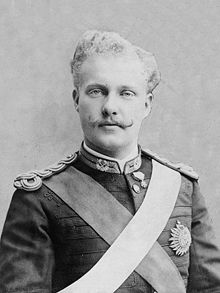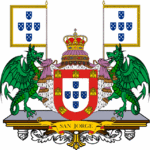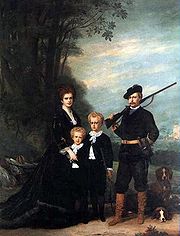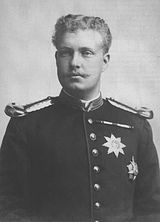- Carlos I of Portugal
-
Carlos I 
King of Portugal and the Algarves Reign 19 October 1889—1 February 1908 Predecessor Luis I Successor Manuel II Duke of Braganza Reign 28 September 1863— 19 October 1889 Predecessor Miguel II Successor Luis I Spouse Amélie of Orléans Issue Luís Filipe, Prince Royal of Portugal
Manuel IIFull name Carlos Fernando Luís Maria Victor Miguel Rafael Gabriel Gonzaga Xavier Francisco de Assis José Simão House House of Braganza-Saxe-Coburg and Gotha Father Louis I Mother Maria Pia of Savoy Born 28 September 1863
Lisbon, Kingdom of PortugalDied 1 February 1908 (aged 44)
Terreiro do Paço, Lisbon, Kingdom of PortugalBurial Dynasty of Braganza Royal Pantheon, Monastery of São Vicente de Fora, Lisbon, District of Lisbon, Portugal Carlos (Portuguese pronunciation: [ˈkaɾɫuʃ] the Diplomat (also known as the Martyr; Portuguese: o Diplomata and o Martirizado; 28 September 1863 – 1 February 1908) was the King of Portugal and the Algarves. He was the first Portuguese king to die a violent death since Sebastian of Portugal (1578). This occurred in 1908, when D. Carlos was murdered in Lisbon as he travelled in an open carriage with the royal family.
Contents
Early life
Carlos was born in Lisbon, Portugal, the son of King Luís and Queen Maria Pia of Savoy, daughter of Victor Emmanuel II, King of Italy. He had a brother, Infante Afonso, Duke of Porto. He was baptised with the names Carlos Fernando Luís Maria Víctor Miguel Rafael Gabriel Gonzaga Xavier Francisco de Assis José Simão.
His paternal first cousins included Frederick Augustus III of Saxony, Princess Maria Josepha of Saxony, Prince Wilhelm of Hohenzollern-Sigmaringen and Ferdinand I of Romania.
His maternal first cousins included Napoléon Victor Bonaparte, Victor Emmanuel III of Italy, Emanuele Filiberto, 2nd Duke of Aosta, Vittorio Emanuele, Count of Turin, Luigi Amedeo, Duke of the Abruzzi, Umberto, Count of Salemi.
He had an intense education and was prepared to rule as a constitutional monarch. In 1883 he traveled to Italy, England, France and Germany where he increased his knowledge of the modern civilization of his time. In 1883, 1886 and 1888 he ruled as regent as his father was traveling in Europe, as it became tradition among the Portuguese constitutional kings. His father Luis I advised him to be modest and to study with focus.
His first bridal candidate was one of the daughters of Frederick III, German Emperor, but the issue of religion presented an insurmountable problem and the pressure of British diplomacy prevented the marriage. He then met and married Princess Amélie of Orléans, eldest daughter of Philippe, comte de Paris, pretender to the throne of France.
King of Portugal
Carlos became King on 19 October 1889. Colonial treaties with the United Kingdom of Great Britain and Ireland (one signed in August 1890 that defined their African borders along the Zambezi and Congo rivers and another signed on 14 October 1899, that confirmed colonial treaties of the 17th century) stabilised the situation in Africa. These agreements were however unpopular in Portugal where they were seen as being to the disadvantage of the country.
Domestically, Portugal was twice declared bankrupt - on 14 June 1892, and again on 10 May 1902 - causing industrial disturbances, socialist and republican antagonism and press criticism of the monarchy. Carlos responded by appointing João Franco as prime minister and subsequently accepting parliament's dissolution.
As a patron of science and the arts, King Carlos took an active part in the celebration of the 500th anniversary (in 1894) of the birth of Prince Henry the Navigator. The following year he decorated the famous Portuguese poet João de Deus in a ceremony in Lisbon. Carlos took a personal interest in deep-sea and maritime exploration, publishing an account of his own studies in this area.
Royal styles of
King Carlos I of Portugal
Reference style His Most Faithful Majesty Spoken style Your Most Faithful Majesty Alternative style Sire Assassination
On 1 February 1908 the royal family returned from the palace of Vila Viçosa to Lisbon. They travelled by train to Barreiro and, from there, they took a steamer to cross the Tagus River and disembarked at Cais do Sodré in central Lisbon. On their way to the royal palace, the open carriage with Carlos I and his family passed through the Terreiro do Paço fronting on the river. While crossing the square, shots were fired from the crowd by two republican activists: Alfredo Costa and Manuel Buiça.
Buiça, a former army sergeant and sharpshooter, fired five shots from a rifle hidden under his long overcoat. The king died immediately, his heir, Luís Filipe, was mortally wounded, and Prince Manuel was hit in the arm. The Queen alone escaped injury. The two assassins were killed on the spot by police and bodyguards; an innocent bystander was also killed in the confusion. The royal carriage turned into the nearby Navy Arsenal, where, about twenty minutes later, the Prince Royal Luis Filipe died. Several days later, the younger son, Prince Manuel, was proclaimed King of Portugal; he was the last of the Braganza-Saxe-Coburg and Gotha dynasty and the last king as well.
Marriage and children
Carlos was married to Princess Princess Amélie of Orléans in 1886. She was daughter of Prince Philippe, Count of Paris and Princess Marie Isabelle of Orléans. Their children were:
- Luis Filipe, Duke of Braganza (1887–1908).
- Infanta Maria Ana of Portugal (1888).
- Manuel II, King of Portugal between 1908 and 1910 (1889–1932).
Maria Pia de Saxe-Coburgo e Bragança (1907–1995) had claimed (many years after his death) that she was the bastard daughter of King Carlos I by Maria Amélia Laredó e Murça.
Ancestry
References
- Jean Pailler: D. Carlos I - Rei de Portugal: Destino Maldito de um Rei Sacrificado. Bertrand, Lisbon, 2001, ISBN 978-97-2251-231-2
- Jean Pailler: Maria Pia: A Mulher que Queria Ser Rainha de Portugal. Bertrand, Lisbon, 2006, ISBN 972-25-1467-9
- Manuel Amaral: Portugal - Dicionário Histórico, Corográfico, Heráldico, Biográfico, Bibliográfico, Numismático e Artístico, Volume II, 1904–1915, págs. 759
- Rui Ramos: D. Carlos, Temas e Debates, Lisbon, 2007.
Carlos I of PortugalBorn: 28 September 1863 Died: 1 February 1908Regnal titles Preceded by
Luís IKing of Portugal and the Algarves
1889 – 1908Succeeded by
Manuel IIPortuguese royalty Preceded by
AugustusPrince Royal of Portugal
1863 – 1889Succeeded by
Luís FilipeVacant Title last held byPedro VDuke of Braganza
1863 – 1889Monarchs of Portugal Afonsine Dynasty Afonso I • Sancho I • Afonso II • Sancho II • Afonso III • Denis • Afonso IV • Peter I • Ferdinand I
House of Aviz House of Aviz-Beja Philippine Dynasty House of Braganza House of Braganza-Coburg Infantes of Portugal The generations indicate descent form Afonso I, and continues through the House of Aviz, the House of Bourbon through Isabella of Portugal, and the House of Braganza through Infanta Catherine, Duchess of Braganza.1st Generation 2nd Generation Infante Raimundo • Afonso II • Infante Pedro, Count of Urgell • Infante Fernando, Count of Flanders • Infante Henrique3rd Generation 4th Generation 5th Generation Infante Afonso, Lord of Leiria • Afonso IV6th Generation 7th Generation Infante Luís • Ferdinand I • Infante Afonso • Infante João, Duke of Valencia de Campos • Infante Dinis, Lord of Cifuentes8th Generation Infante Pedro • Infante Afonso • Infante Afonso • Edward I • Infante Pedro, 1st Duke of Coimbra • Infante Henrique, 1st Duke of Viseu • Infante João, Lord of Reguengos de Monsaraz • Infante Fernando, the Saint Prince9th Generation Infante Miguel^ • Infante Diogo, Constable of Portugal • Infante João • Peter V, King of Aragon • Infante João, Prince of Antioch • Afonso V • Cardinal-Infante Jaime • Infante Fernando, 2nd Duke of Viseu • Infante Duarte10th Generation Infante João, 3rd Duke of Viseu • Infante Diogo, 4th Duke of Viseu • João, Prince of Portugal • John II • Infante Duarte • Infante Diniz • Infante Simião • Infante Afonso • Manuel I11th Generation Afonso, Prince of Portugal • Infante João • Miguel da Paz, Prince of Portugal and Asturias^ • John III • Infante Luís, 5th Duke of Beja • Infante Fernando, Duke of Guarda and Trancoso • Cardinal-Infante Afonso • Henry, The Cardinal-King • Infante Duarte, 4th Duke of Guimarães • Infante António • Infante Carlos12th Generation Afonso, Prince of Portugal • Manuel, Prince of Portugal • Filipe, Prince of Portugal • Infante Dinis • John Manuel, Prince of Portugal • Infante António13th Generation 14th Generation 15th Generation Balthasar Charles, Prince of Portugal and Asturias* • Infante Francisco Fernando* • Teodósio, 1st Prince of Brazil • Afonso VI • Peter II16th Generation João, 3rd Prince of Brazil • John V • Infante Francisco, 7th Duke of Beja • Infante António • Infante Manuel, Count of Ourém •17th Generation 18th Generation none19th Generation 20th Generation Francisco António, 8th Prince of Beira • Peter I of Brazil & IV of Portugal • Miguel I • Infante Pedro Carlos* • Infante Carlos José Antonio*21st Generation 22nd Generation Pedro V • Luís I • Infante João, 8th Duke of Beja • Infante Fernando • Infante Augusto, 3rd Duke of Coimbra • Infante Leopoldo • Infante Eugénio Maria • Infante Miguel, 6th Duke of Viseu • Infante Francisco José • Infante Duarte Nuno, 25th Duke of Braganza23rd Generation Carlos I • Afonso, Prince Royal and 3rd Duke of Porto • Infante Duarte Pio, Duke of Braganza • Infante Miguel, Duke of Viseu • Infante Henrique, Duke of Coimbra24th Generation Luís Filipe, Prince Royal • Manuel II • Infante Dinis, Duke of Porto • Infante Afonso, Prince of Beira •^also an infante of Castile and León, Aragon, Sicily and Naples, *also an infante of Spain, **claimant infante, ^^only prince or infante by marriage1st generation 
2nd generation Carlos I · Afonso3rd generation Princes of Saxe-Coburg and Gotha, dukes in Saxony 1st generation 2nd generation Ernest II^ · Albert, Prince Consort of the United Kingdom^* · Ferdinand II of Portugal^# · August, Prince of Kohary^ · Prince Leopold^ · Louis-Philippe, Crown Prince of Belgium** · Leopold II of Belgium** · Philippe, Count of Flanders**3rd generation Edward VII* · Alfred* · Arthur, Duke of Connaught and Strathearn* · Leopold, Duke of Albany* · Peter V of Portugal# · Luís I of Portugal# · Infante João, Duke of Beja# · Infante Fernando of Portugal# · Infante Augustus, Duke of Coimbra# · Prince Philipp · Prince Ludwig August · Ferdinand I of Bulgaria · Leopold, Duke of Brabant** · Prince Baudouin** · Albert I of Belgium**4th generation Albert Victor, Duke of Clarence and Avondale* · George V* · Prince Alexander John* · Alfred, Hereditary Prince* · Prince Arthur* · Charles Edward* · Prince Leopold Clement · Prince Peter · Prince August Leopold · Carlos I of Portugal# · Infante Afonso, Duke of Porto# · Prince Joseph · Prince Ludwig · Leopold III of Belgium** · Charles, Count of Flanders**5th generation Edward VIII* · George VI* · Henry, Duke of Gloucester* · George, Duke of Kent* · Prince John* · Alastair, Duke of Connaught and Strathearn* · Hereditary Prince Johann Leopold* · Prince Hubertus* · Prince Friedrich Josias · Prince August Clemens · Prince Rainier · Prince Philip · Prince Ernst · Prince Antonius* · Luís Filipe, Prince Royal of Portugal# · Manuel II of Portugal# ·6th generation 7th generation ^ prince of Saxe-Coburg-Saalfeld until 1826
* also a prince of the United Kingdom of Great Britain and Ireland
** also a prince of Belgium
# also a member of the Portuguese Royal familyCategories:- 1863 births
- 1908 deaths
- 1908 crimes
- Assassinated Portuguese people
- Assassinated royalty
- Burials at the Monastery of São Vicente de Fora
- Deaths by firearm in Portugal
- Dukes of Braganza
- Grand Masters of the Order of the Immaculate Conception of Vila Viçosa
- House of Braganza-Saxe-Coburg and Gotha
- Knights of the Garter
- Murdered monarchs
- Portuguese monarchs
- Princes Royal of Portugal
- Portuguese royalty
- Recipients of the Royal Victorian Chain
- Roman Catholic monarchs
- Knights of the Order of the Most Holy Annunciation
Wikimedia Foundation. 2010.


